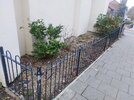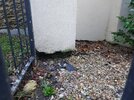Morning,
I bought my house recently and the survey showed high damp readings in the basement on the side of my house. The side garden is also slightly higher than ground floor hallway, so surveyor advised to reduce the side garden level (I’ll dig down 30cm) and improve water run off as any water hitting the side of the house is running into the side foundation, probability causing the basement damp. Basically at the side of the property there are wall remnants from the previously demolished adjacent property 60 years ago and no path was ever laid.
So my question, what could I do to improve water run-off on the side? I was thinking about digging down (so that side garden is lower than hallway 30cm), then laying a patio slopping away from house with a drain gully on edge of property to take water away? I have asked a renderer for a quote to put a plinth at the bottom also.
Or do I lay contrate path? Or waterproof membrane with gravel on top? What would you all do?
Thanks
Matt
I bought my house recently and the survey showed high damp readings in the basement on the side of my house. The side garden is also slightly higher than ground floor hallway, so surveyor advised to reduce the side garden level (I’ll dig down 30cm) and improve water run off as any water hitting the side of the house is running into the side foundation, probability causing the basement damp. Basically at the side of the property there are wall remnants from the previously demolished adjacent property 60 years ago and no path was ever laid.
So my question, what could I do to improve water run-off on the side? I was thinking about digging down (so that side garden is lower than hallway 30cm), then laying a patio slopping away from house with a drain gully on edge of property to take water away? I have asked a renderer for a quote to put a plinth at the bottom also.
Or do I lay contrate path? Or waterproof membrane with gravel on top? What would you all do?
Thanks
Matt






